Dunk your ramen noodles into a rich broth of miso flavoured tsukemen! This easy dipping ramen recipe is a super fun treat to whip up for lunch or dinner, and it’s ready under 20 minutes.
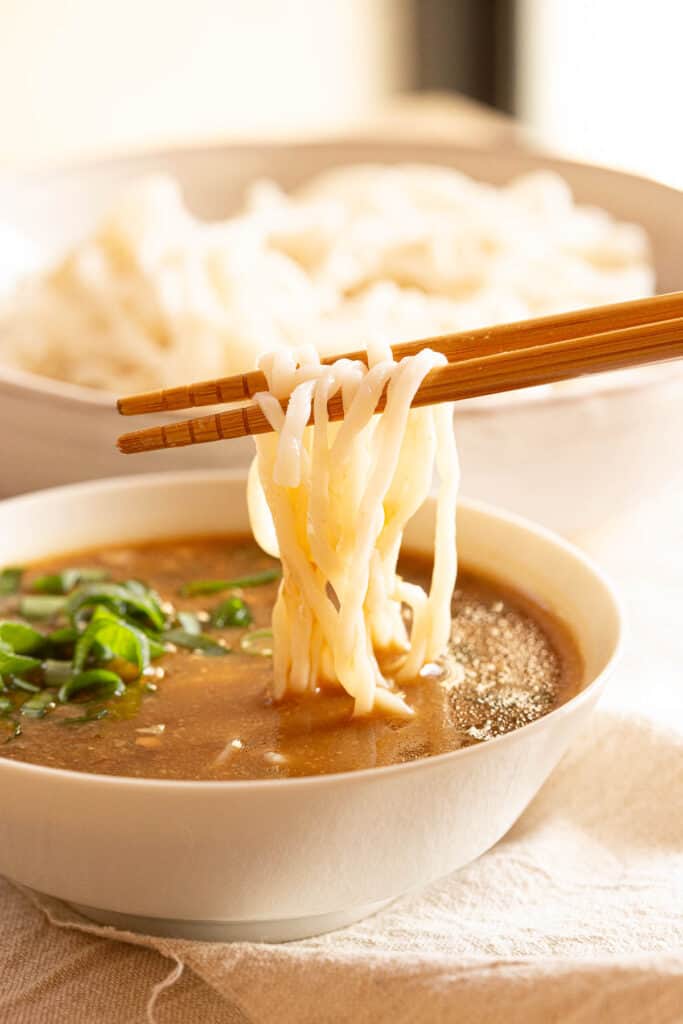
In This Post You’ll Learn
Why We Love This
Tsukemen is Laura’s favourite style of Japanese ramen! Dipping the noodles in the richly seasoned both is super fun and delicious, since the broth clings to every noodle as you dip.
These easy dipping ramen noodles are perfect for any season. Serve piping hot ramen in winter to warm up from the inside out. Or chill the noodles in summer as a refreshing way to cool down.
Related: Spicy Miso Ramen / Tantanmen Ramen
Tsukemen Vs Ramen – What’s the difference?
Both dishes consist of ramen noodles served with broth, but there’s one key difference.
Ramen is the classic Japanese dish of noodles served in a big bowl of broth, loaded with a number of toppings such as pork, ajitama ramen eggs, nori seaweed sheets, corn and menma (fermented bamboo shoots). It comes in a variety of broths, the most popular options being tonkotsu (pork), shoyu (soy sauce broth) and miso paste.
Tsukemen is where the ramen noodles are served separately to the broth. The noodles are then dipped into the rich broth. The soup base is usually thicker and more concentrated than ramen so it sticks to the noodles.
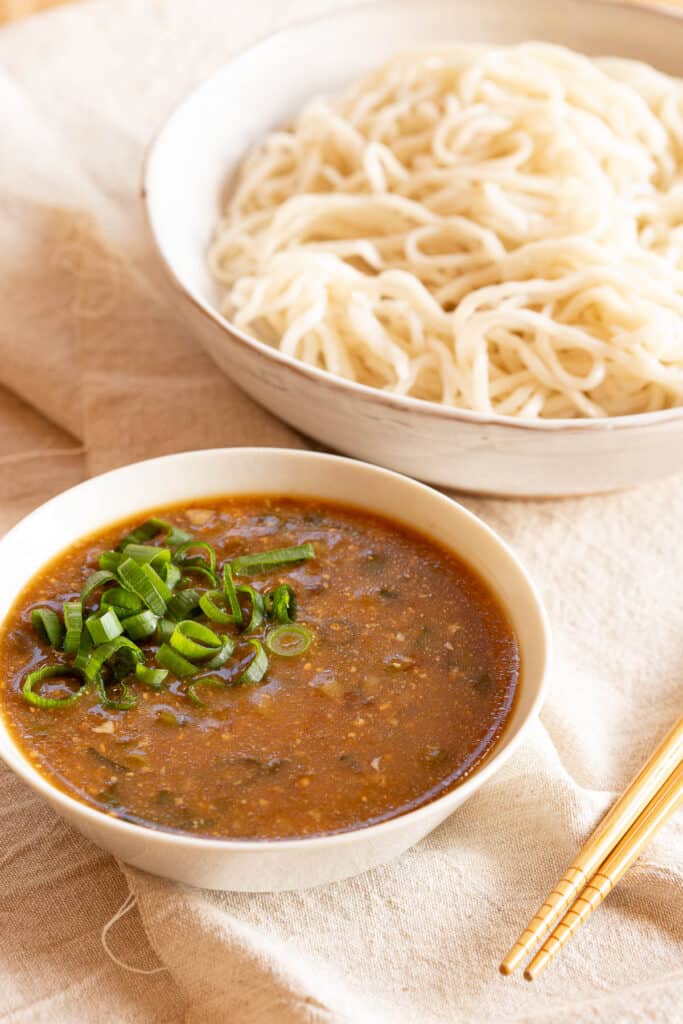
What is Tsukemen?
Tsukemen (つけ麺) is a Japanese noodle recipe that literally translates to dipping ramen. It’s eaten by dipping the ramen directly into the tsukemen broth then slurped up straight from the bowl.
The ramen noodles are usually served on a wide plate or bowl, with the broth served alongside in a separate mall bowl. The broth is intentionally thick and rich in flavour, so it will cling to the noodles as you dunk them and eat.
This particular style of Japanese noodle dish is said to have originated in Tokyo, Japan, by a ramen chef called Kazuo Yamagishi. It’s now popular across Japan and even internationally.
Below is an example of pork tsukemen ramen, which we thoroughly enjoyed after riding the kibiji trail in Okayama, Japan. You can see how chunky the soup base can be!
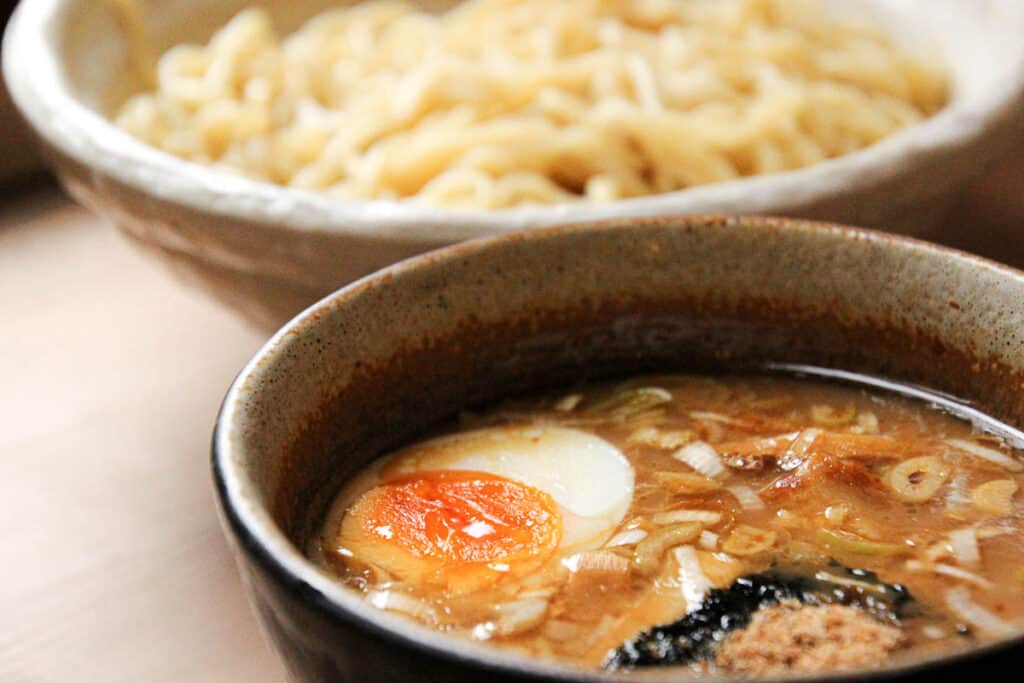
What You’ll Need
- Ramen Noodles – This best noodles to use are wheat-based fresh ramen noodles which can be sourced from an Asian grocery or market. They are the key to that delicious chewy texture you’re looking for. But to keep things easy you can use either dry ramen noodles or shelf stable noodles cooked to packet directions. You don’t even have to use ramen – you could use homemade udon noodles or soba noodles if you prefer.
- Spring Onion / Green Onion – Adding a little crunch and freshness to the dish, try to pick smaller spring onion as it’s sweeter and goes well alongside the other toppings.
- Ginger and Garlic – Fresh chopped ginger and garlic work best. It gives the broth a nice flavour punch!
- Mirin / Sugar – Mirin is a sweet Japanese rice wine for cooking. You can also use sugar if you need.
- Rice Wine Vinegar – Look for this in the international aisle at your local supermarket, otherwise head to an Asian grocer or buy online. If you don’t have this, you can substitute for apple cider vinegar, white wine vinegar, or white vinegar.
- Chicken Stock – A nice mild soup base. Sub with any preferred stock such as beef, vegetable or dashi stock.
- Red Miso Paste – Sub with half red and half white miso paste or just white for milder flavour.
- Bonito Flakes / Katsuobushi– Bonito Flakes (Katsuobushi in Japanese) are skipjack tuna flakes that have been simmered, smoked and fermented to help give dashi the umami kick.
- Rayu Chilli Oil – This delicious Japanese condiment is the perfect blend of sesame oil and chilli without being over the top spicy. You can easily make rayu oil at home, find it at Asian groceries or buy online if needed. To substitute, just use regular sesame oil with a sprinkling of chilli powder to taste.
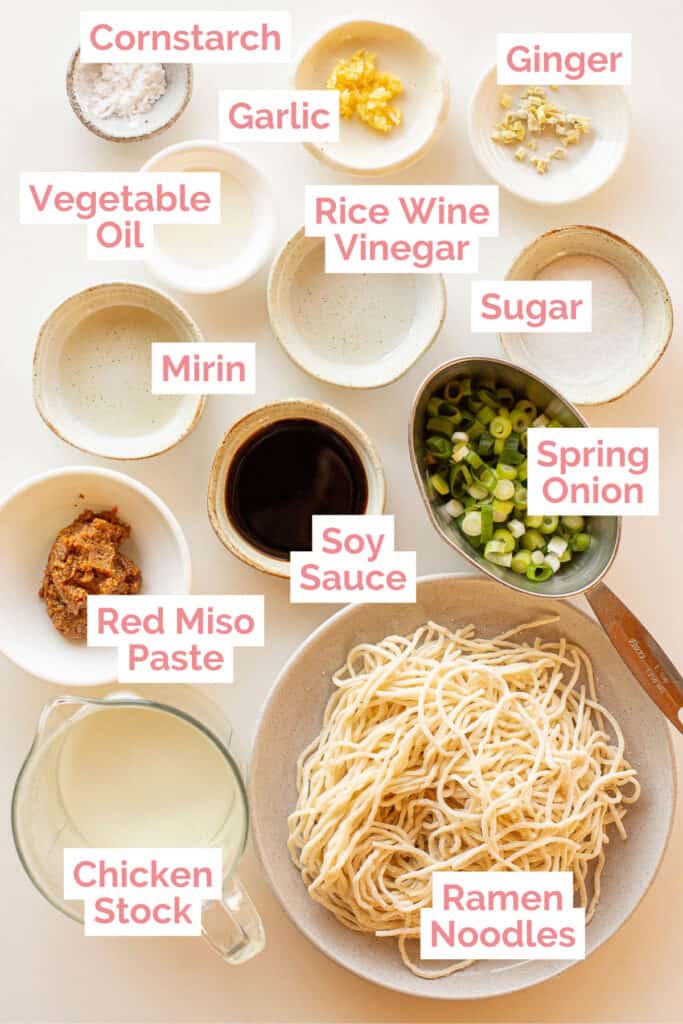
How to Make Tsukemen at Home
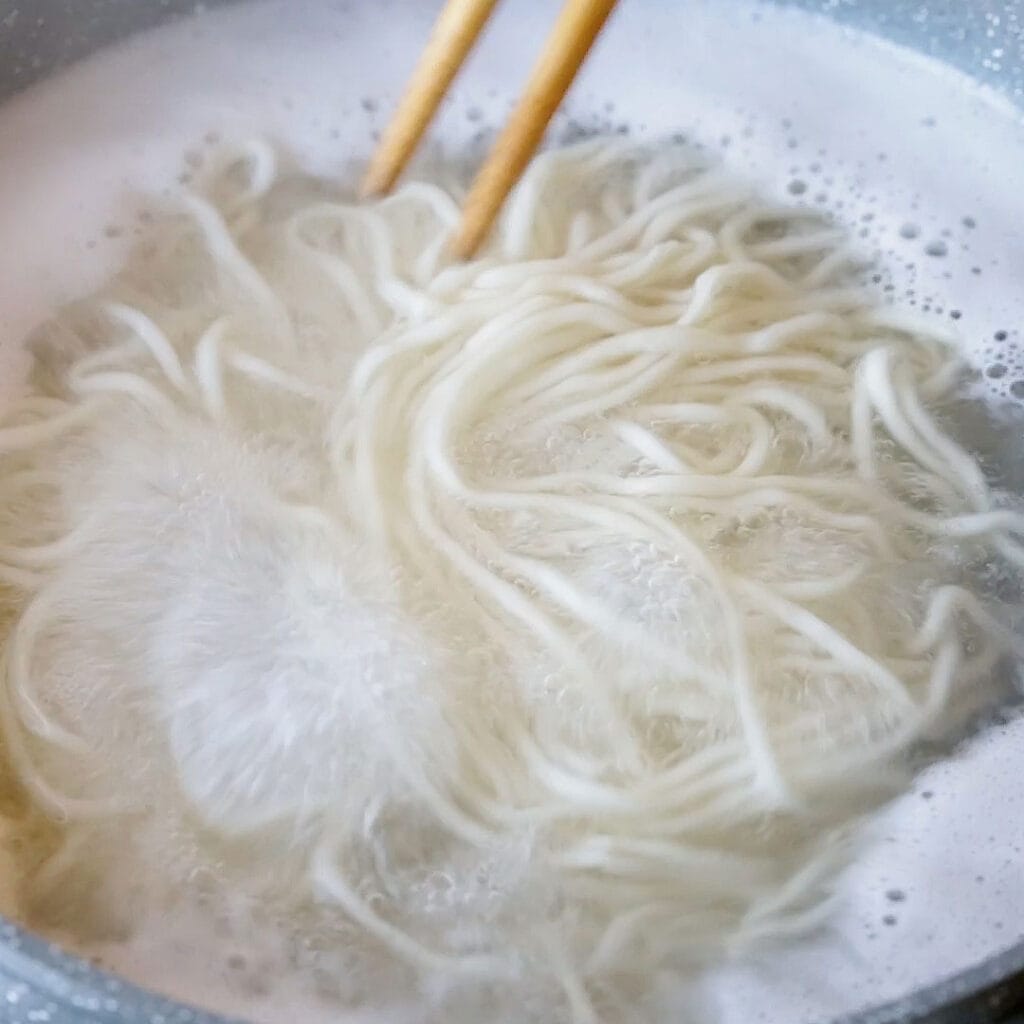
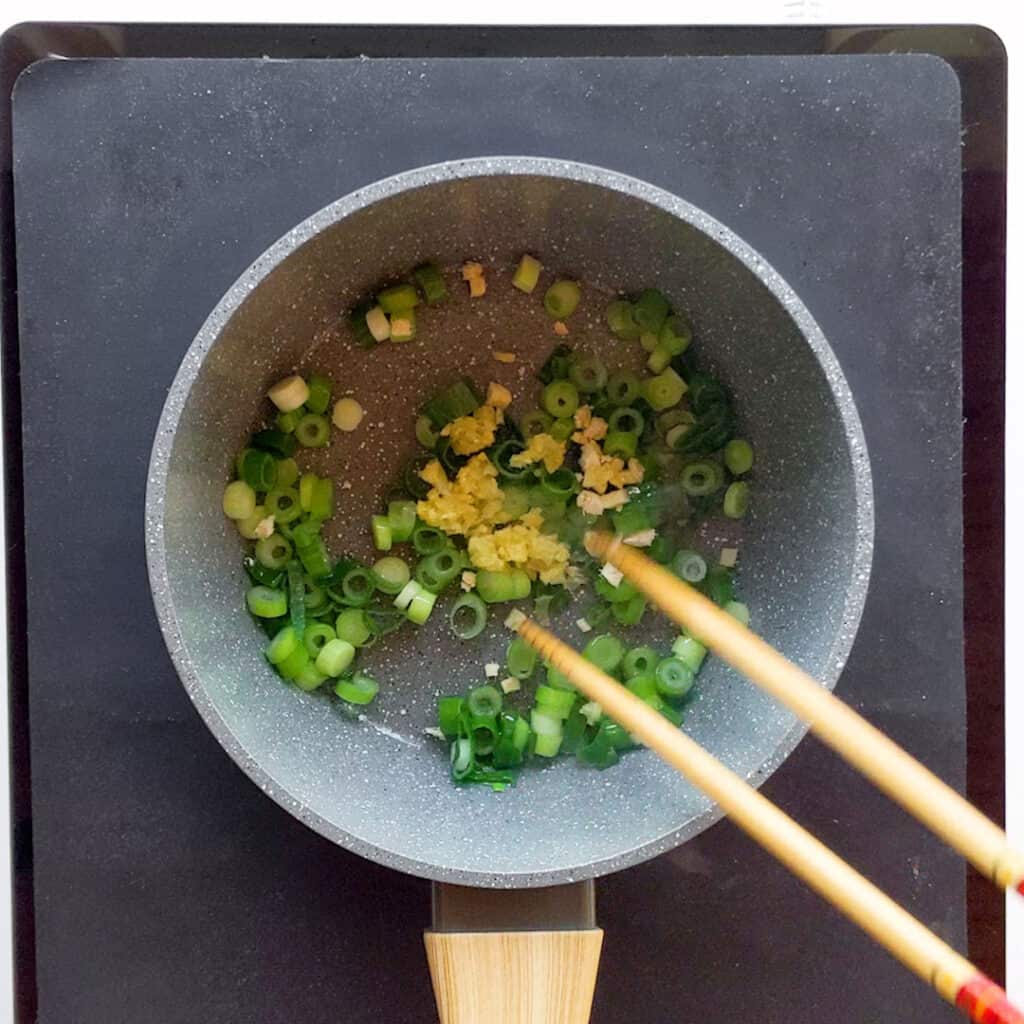
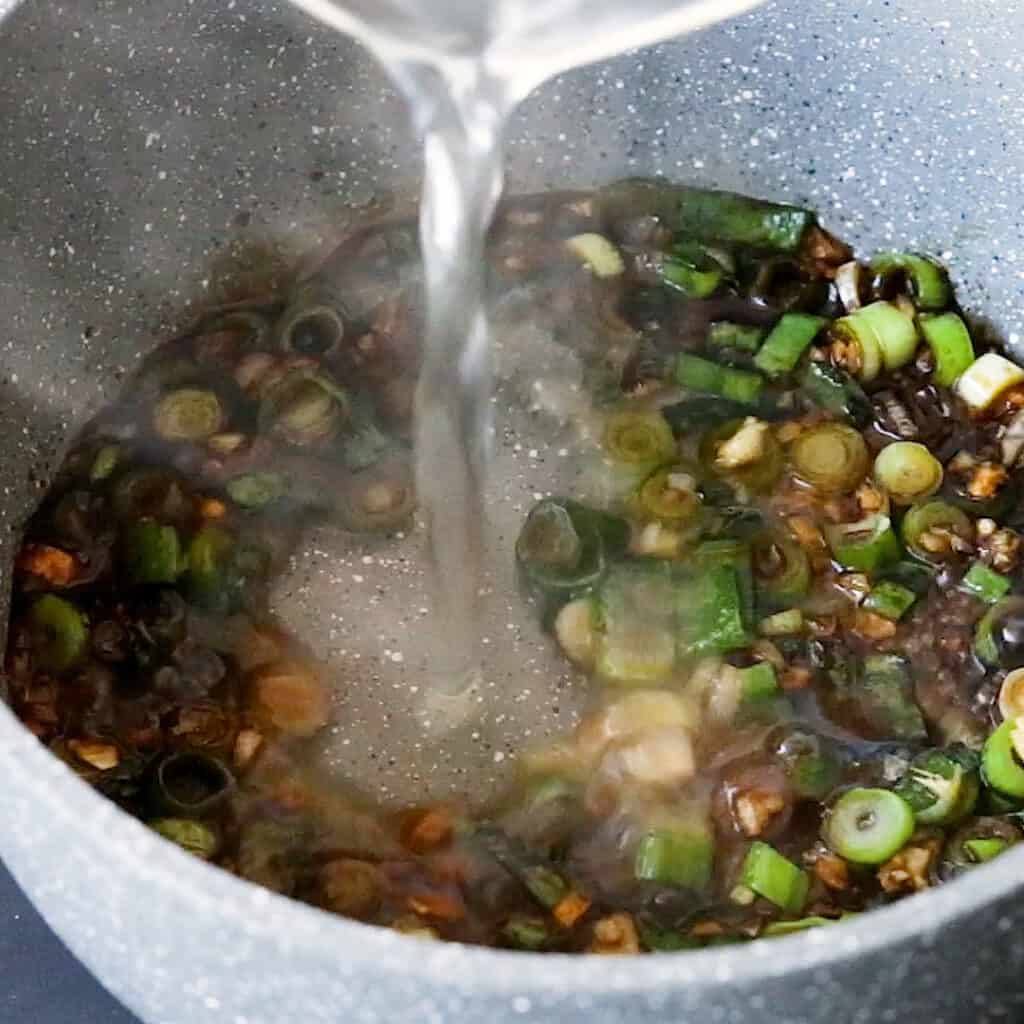
First, gather your ingredients: See recipe card below for measurements.
- Cook the ramen noodles according to packet directions. Drain and sit aside if you want them warm, or run under cold water if you prefer cold noodles.
- Heat the vegetable oil in a small saucepan over a low-medium heat. Add the spring onion, ginger and garlic and fry for 1-2 mins until fragrant.
- Add the soy sauce, mirin, sugar, rice wine vinegar and chicken stock then increase the heat to medium-high and bring to the boil. Add the katsuobushi / bonito flakes and stir again.
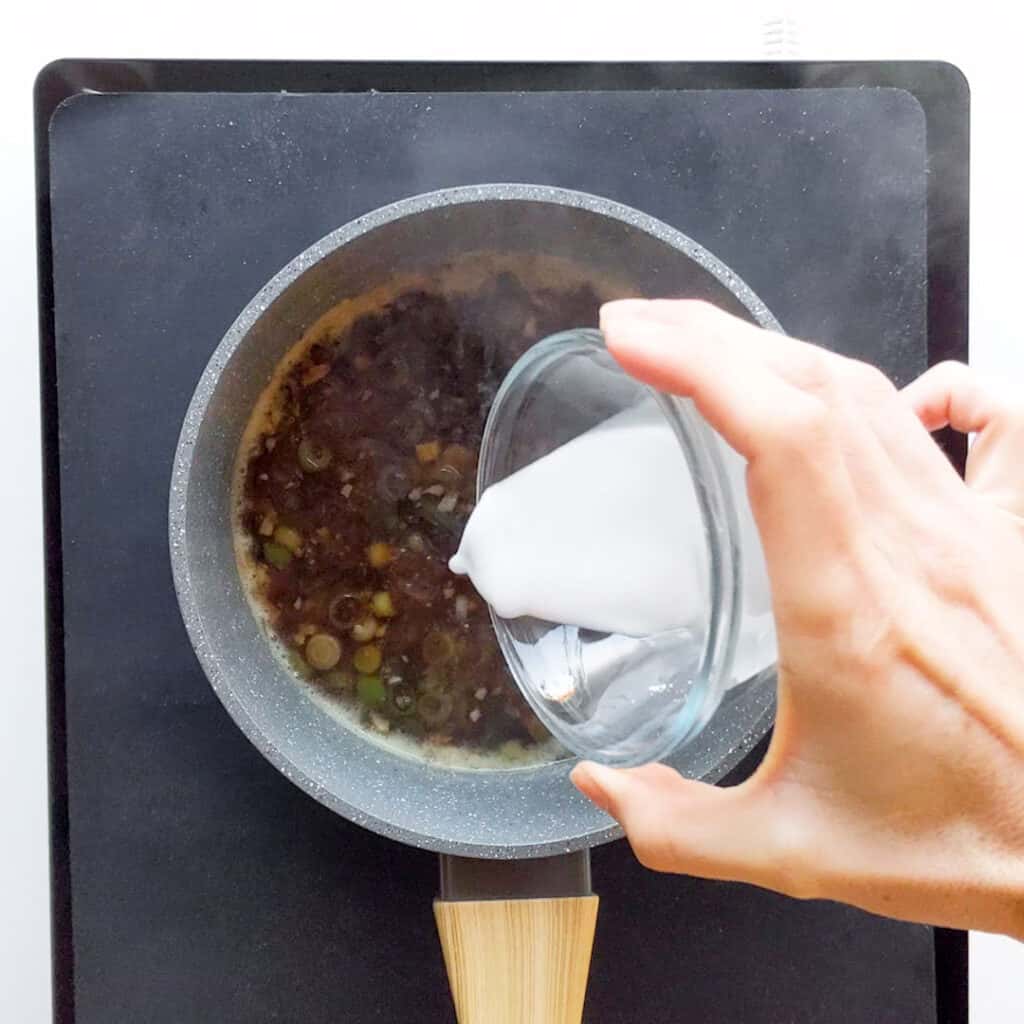
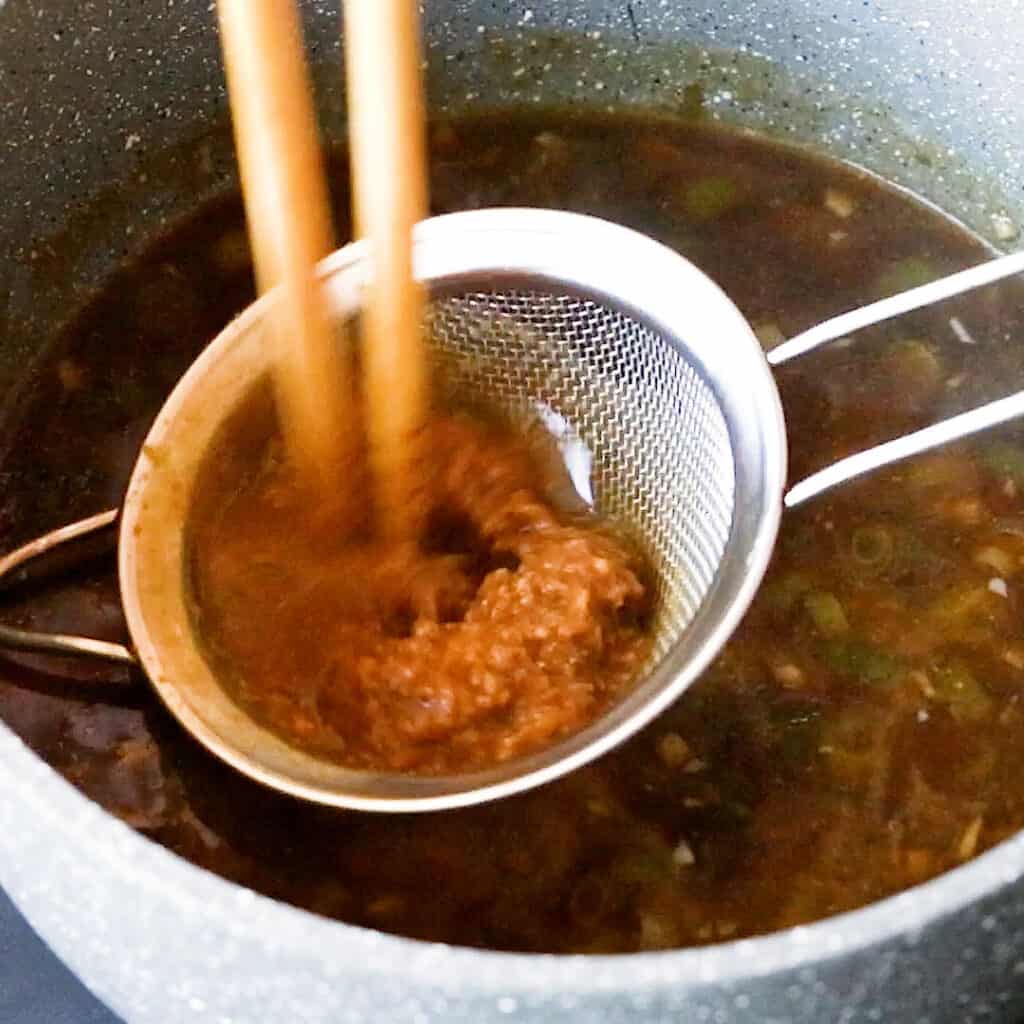
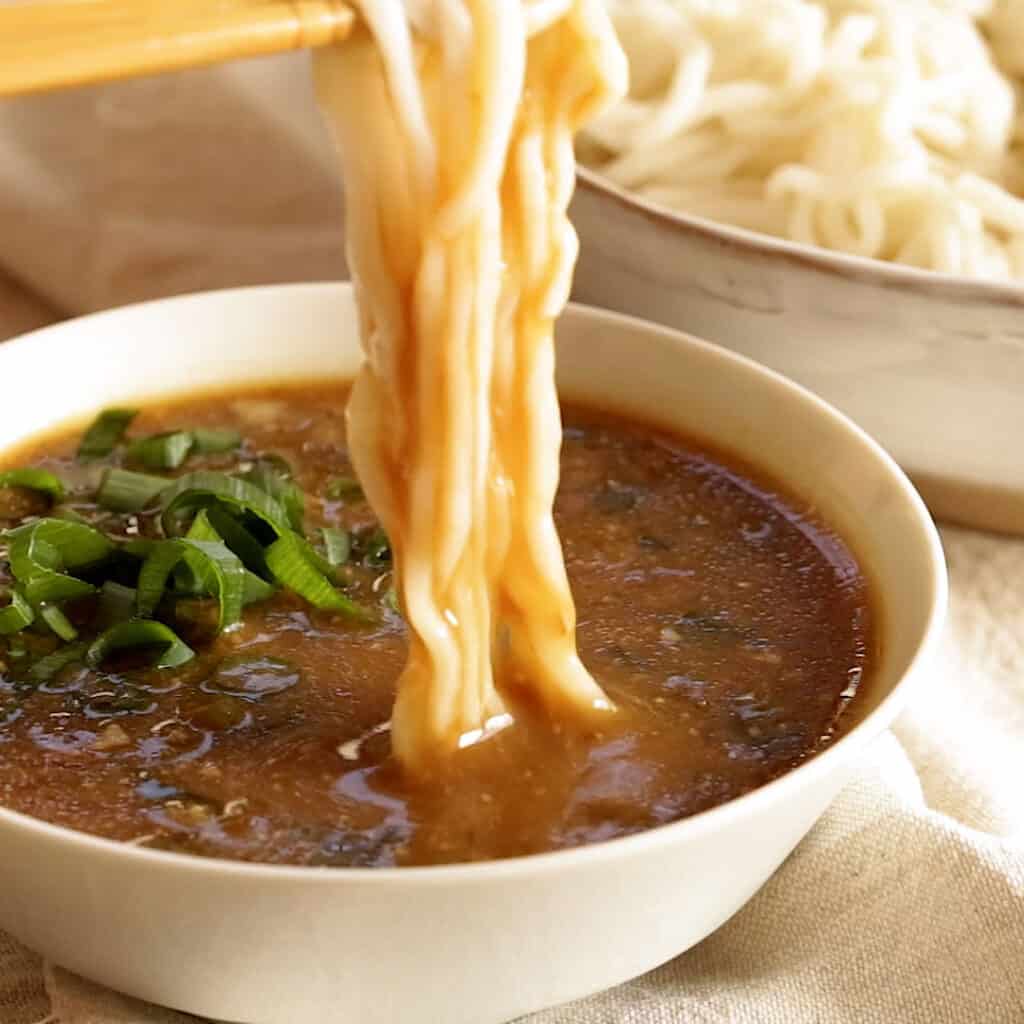
- In a small dish, mix together the cold water and cornstarch / cornflour to form a slurry. Pour into the soup and stir to thicken (around 1-2 minutes). Turn off the heat.
- Place the red miso into a strainer and dunk into the soup. Use a spoon to dissolve the miso paste.
- Optional: Add the rayu chilli oil and stir through. Portion out the tsukemen soup into two small bowls. Place the ramen noodles into separate bowls ready to dip.
Wandercook’s Tips
- Ramen Noodles – Serve hot or run them under cold water to chill. It’s up to you! Either way, drain well before serving so they don’t dilute the flavour of the dipping broth too much.
- Make Ahead – You can always make the broth and noodles the night before if you want to take them for a work lunch. Just store both separately in airtight containers in the fridge.
- Storage – While we don’t recommend freezing the noodles or tsukemen broth, you can store both in the fridge for up to a couple of days. We recommend cooking the ramen noodles right before you’re eating them though for the freshest results.
FAQs
Pick up a small amount of ramen noodles with your chopsticks and dip them into your tsukemen soup before slurping it up together, straight out of the tsukemen bowl.
You shouldn’t drink the tsukemen broth straight, as it’s concentrated so it will stick to the noodles, so it will be quite salty. If you have some broth leftover, add a cup of chicken stock to mellow the flavours and enjoy as a soup.
There are many tsukemen broth variations. The most popular is a pork based broth, which takes a lot of time and energy. Miso is another favourite, and the easiest to make it at home.
Some ramen restaurants will have speciality tsukemen flavours such as yuzu or even cheese tsukemen!
Variations
- Toppings – Make it a bigger meal by adding things like boiled eggs, nori seaweed sheets, kamaboko fish cake slices, chashu pork belly slices or pile on some nikumiso pork meat sauce. You could also sprinkle some shichimi togarashi chilli powder, toasted sesame seeds or gomashio sesame salt over the broth before serving.
- Leftover noodles? – Save them for another meal and serve with cold soba noodle sauce (aka mentsuyu dipping sauce) or fried in miso butter.
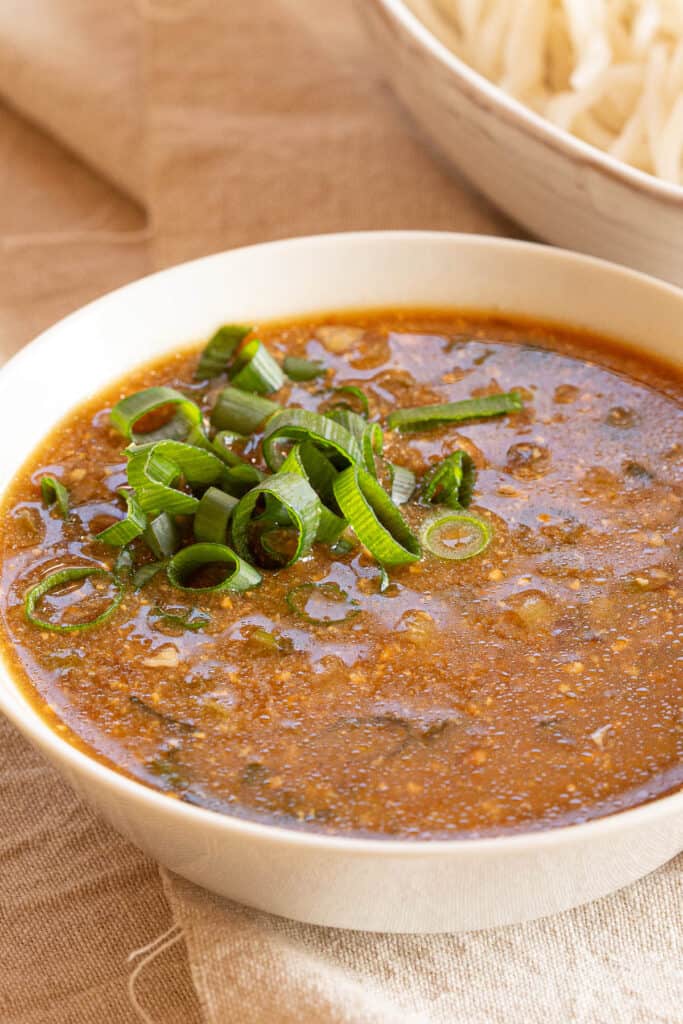
Try these amazing recipes next:
★ Did you make this recipe? Please leave a comment and a star rating below!
Ingredients
- 250 g ramen noodles 8.8 oz
- ½ tbsp vegetable oil
- ½ cup spring onion sliced
- 1 tsp ginger
- 1 tsp garlic
- 1 tbsp soy sauce
- ½ tbsp mirin
- 1 tsp sugar
- 1 tsp rice wine vinegar
- 200 ml chicken stock 7 fl oz, sub dashi stock
- 2 tbsp bonito flakes / katsuobushi
- 1 tbsp cold water
- 2 tsp cornstarch / cornflour
- 2 tbsp red miso paste
Optional garnishes:
- 1/4 tsp rayu chilli oil
Instructions
- Cook the ramen noodles according to packet directions. Drain and sit aside if you want them warm, or run under cold water if you prefer cold noodles.250 g ramen noodles
- Heat the vegetable oil in a small saucepan over a low-medium heat. Add the spring onion, ginger and garlic and fry for 1-2 mins until fragrant.½ tbsp vegetable oil, ½ cup spring onion, 1 tsp ginger, 1 tsp garlic
- Add the soy sauce, mirin, sugar, rice wine vinegar and chicken stock then increase the heat to medium-high and bring to the boil. Add the katsuobushi / bonito flakes and stir again.1 tbsp soy sauce, ½ tbsp mirin, 1 tsp sugar, 1 tsp rice wine vinegar, 200 ml chicken stock, 2 tbsp bonito flakes / katsuobushi
- In a small dish, mix together the cold water and cornstarch / cornflour to form a slurry. Pour into the soup and stir to thicken (around 1-2 minutes). Turn off the heat.1 tbsp cold water, 2 tsp cornstarch / cornflour
- Place the red miso into a strainer and dunk into the soup. Use a spoon to dissolve the miso paste.2 tbsp red miso paste
- Optional: Add the rayu chilli oil and stir through.1/4 tsp rayu chilli oil
- Portion out the tsukemen soup into two small bowls. Place the ramen noodles into separate bowls ready to dip.
Video
Recipe Notes
- Ramen Noodles – Serve your noodles hot or cold, it’s up to you!
- Make Ahead – You can always make the broth and noodles the night before if you want to take them for a work lunch. Just store both separately in airtight containers in the fridge.
- Storage – While we don’t recommend freezing the noodles or tsukemen broth, you can store both in the fridge for up to a couple of days. We recommend cooking the ramen noodles right before you’re eating them though for the freshest results.
- Toppings – Make it a bigger meal by adding things like boiled eggs, nori seaweed sheets, chashu pork slices or pile on some nikumiso.
Nutrition


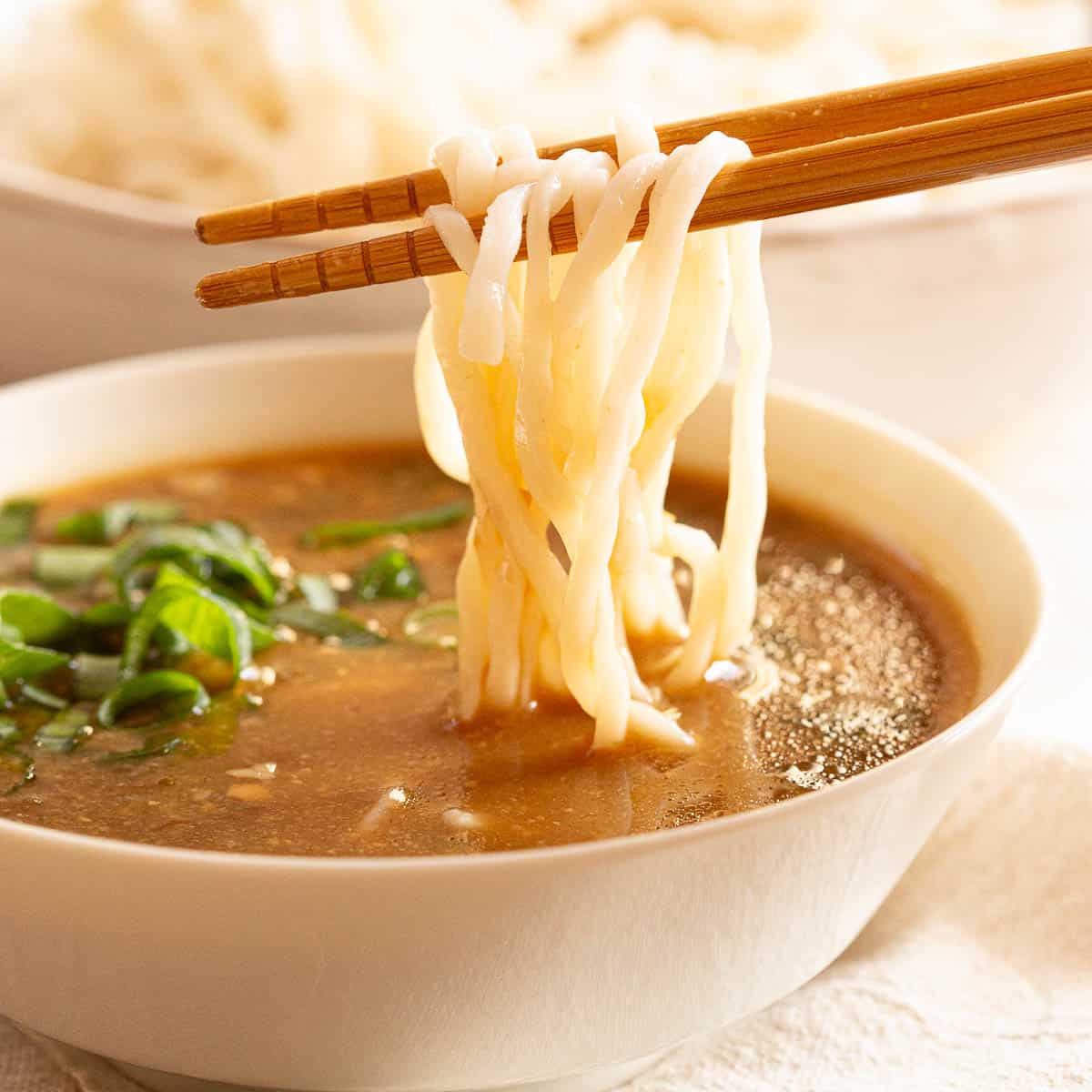



2 Comments
Brooke
12/01/2023 at 4:00 pmForgive me, I actually have not made, but I wanted to shout out thanks to you for your wonderful recipes and good humor, for lack of better words at the moment.
Wandercooks
13/01/2023 at 3:42 pmOh thanks Brooke! You’re very welcome, and happy cooking adventures ahead!